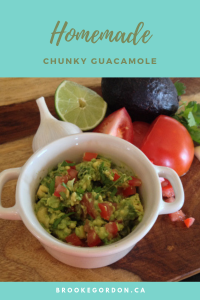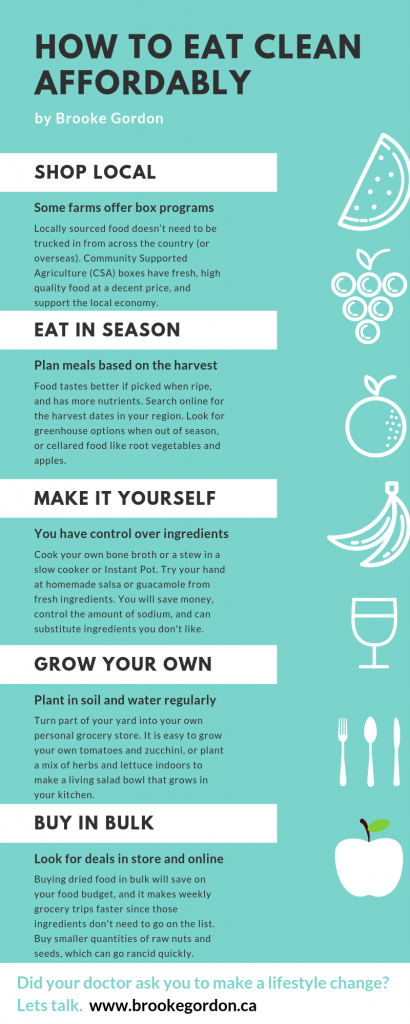One of the big concerns when people consider eating clean or eating healthier is cost. Grocery prices have gone up significantly in the past few years, especially for fresh fruit and vegetables.
Shop Local
Find your local farmers market and scout out farm stores in the area. They are a great source of local produce, diary, and eggs and even meat. My sister buys half-a-cow, pre-cut and packaged in butcher’s paper as roasts, ground beef and ribs. She keeps it frozen in a small chest-freezer (labelled with the purchase date).
CSA (Community Supported Agriculture) boxes are another great source of local produce. You buy a share of a farmerís produce for the year and end up with a box of assorted fruits and vegetables throughout the growing season. Go to http://www.localharvest.org/csa/ to learn more and find farms in your area that participate. A quick search showed up with 5 near my town, and there are often central drop-points at local churches or libraries.
Since these items don’t need to be trucked in from across the country (or overseas), you’re getting fresh, high quality food at a decent price, and supporting the local economy.
Eat In Season
Eat the food that’s in season any given month. Again, it will be cheaper, both in the grocery store and at the farmer’s market, but also be fresher. Plus there are additional benefits to eating in season. The food tastes better and has higher nutrient content when it’s ripe. Food that is picked early and shipped across the country puts a strain on the environment and your health.
More southern climbs have a longer growing season but in Ontario, we have the most selection between June and September but with greenhouses and root vegetables there are more choices than the weather allows. Foodland Ontario has helpful guides to learn more and find out what’s fresh in any given month.
Make It From Scratch
Many of us have lost the art of making things from scratch in the past few decades. We spend our hard earned money on a tetra pack of sodium free, organic chicken broth instead of boiling up the bones from the chicken we had for dinner last night and making our own.
 I highly recommend learning to cook food from scratch. Soak and cook your own beans, make soups and stews and bone broth in a slow cooker or Instant Pot. Try your hand at homemade salsa or guacamole made from fresh ingredients.
I highly recommend learning to cook food from scratch. Soak and cook your own beans, make soups and stews and bone broth in a slow cooker or Instant Pot. Try your hand at homemade salsa or guacamole made from fresh ingredients.
Add to your goals this year to learn to make one new recipe each week. Not only will you save money, you also get full control over the ingredients and the amount of sodium.
[purchase_link id=”718″ style=”button” color=”dark-gray” text=”Homemade chunky guacamole recipe”]
Grow Your Own
Turn part of your yard into your own personal grocery store. It is easy to grow your own tomatoes and zucchini. Local stores sell seedlings or get started with seeds. Plant them in soil and water regularly. As an added bonus you get outside to get a dose of Vitamin D.
You can plant vegetables in containers on your patio or balcony, or grow herbs indoors all year round. Try planting a variety of herbs and mixed lettuce to make a living salad bowl. You can grow these greens in a pot or mason jar near the kitchen window, cut off only what you need for a recipe, and enjoy a nice bowl of fresh salad every few days.
Buy In Bulk
Last but not least, consider buying in bulk. You can purchase staple foods like rice, dried beans and lentils (or split peas). See what your local grocery store has to offer, or if you can get better prices online. Just be sure to factor in the cost of shipping through online sites. The only foods to buy in smaller quantities are raw nuts and seeds, which can go rancid quickly.
I go to stores that sell in bulk to buy larger bags of hemp hearts and chia seeds (which I keep in the fridge once opened), and steel cut oats. I also buy smaller quantities of dried herbs and spices and replenish them as they get used.
Buying dried food in bulk will save you quite a few dollars on your food budget and it makes weekly grocery trips faster since those ingredients don’t need to go on the list.
Final thoughts.
Not only is it very doable to incorporate healthy foods on a limited budget but you’ll be able to model this lifestyle for others in your family and potentially save down the road in avoided health care costs.
